#156 CE
Explore tagged Tumblr posts
Photo

La Mojarra Stela 1 is a Mesoamerican carved monument (stela) dating from 156 CE[1] (2nd century CE). It was discovered in 1986, pulled from the Acula River near La Mojarra, Veracruz, Mexico, not far from the Tres Zapotes archaeological site. The 4+1⁄2-foot-wide (1.4 m) by 6+1⁄2-foot-high (2.0 m), four-ton limestone slab contains about 535 glyphs of the Isthmian script. One of Mesoamerica's earliest known written records, this Epi-Olmec culture monument not only recorded this ruler's achievements, but placed them within a cosmological framework of calendars and astronomical events.[2]
#La Mojarra Stela 1#mesoamerica#156 CE#Acula river#La Mojarra#veracruz#mexico#tres zapotes#isthmian#isthmian script#epi-olmec#astronomy
2 notes
·
View notes
Text
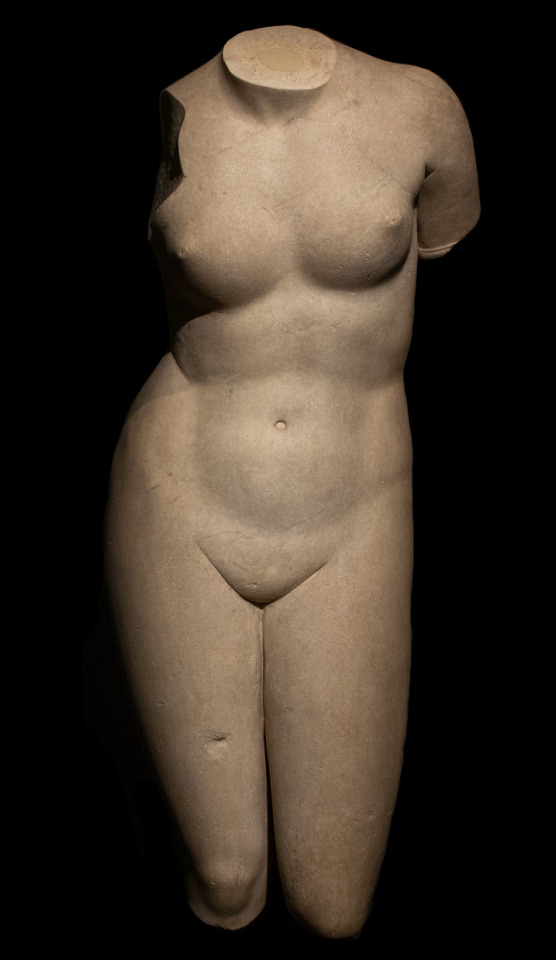
156 - Torse du type de l'Aphrodite de Cnide d'après un original de Praxitèle Marbre de Thasos IIème siècle après Jésus-Christ Musée du Louvre
Ce torse est du type de l'Aphrodite attribuée au sculpteur athénien Praxitèle, créée autour de 350 avant notre ère, et qui fut placée au sanctuaire de la déesse à Cnide.
#art#sculpture#mediterranean#venus#mythological art#praxitele#Praxiteles#aphrodite#fine art#european art#classical art#europe#european#fine arts#europa
170 notes
·
View notes
Photo

Britannicus
Britannicus (41-55 CE) was the second child and only son born to the Roman emperor Claudius (r. 41-54 CE) and Valeria Messalina (c. 20-48 CE). Seen as a threat by Claudius' fourth wife, Agrippina the Younger (15-59 CE), and her son, the future Nero (r. 54-68 CE), Britannicus was poisoned the night before his 14th birthday.
Early Childhood
Born on 12 February 41 CE, he was originally named Tiberius Claudius Caesar Germanicus; the name Britannicus was added after his father's invasion of Britain. In his The Twelve Caesars, the ancient historian Suetonius (69 to 130/140 CE) wrote, "Claudius would often pick little Britannicus up and show him to the troops or to the audience at the games either seated on his lap or held at arm's length" (197) Claudius had a son by his first wife Urgulanilla, but the boy died accidentally before coming of age, and Britannicus became the obvious choice to assume the purple upon the emperor's death. However, this would soon change when Claudius married his niece Agrippina the Younger (15-59 CE). The emperor's new wife brought with her a hidden agenda; she had high aspirations for her son, the future emperor Nero (r. 54-68 CE).
Agrippina the Younger was the daughter of Emperor Tiberius' (r. 14-37 CE) nephew Germanicus (15 BCE to 19 CE) and Agrippina the Elder (14 BCE to 33 CE), making her the great-granddaughter of Augustus (r. 27 BCE to 14 CE). Her marriage to Gnaeus Domitius Ahenobarbus produced one son Lucius Domitius Ahenobarbus, the future Nero (b. 37 CE). Gnaeus, who died when Nero was three, was extremely violent and was described by his contemporaries as "a despicable character." Two years after Domitius' birth, Agrippina was exiled by her brother Caligula (r. 37-41 CE). After Caligula's assassination in 41 CE, one of Claudius' first acts was to recall her. Her strong ties to the Julio-Claudians would pose a serious challenge to young Britannicus' position as the emperor's heir and, unfortunately for Britannicus, the highly aggressive Agrippina would stop at nothing until little Domitius upended his position. According to Matthew Dennison in his The Twelve Caesars, Agrippina "was not distracted by bodily appetites; arrogance and an undistracting focus steadied her performance." (156)
In 40 CE Domitius' father died of dropsy. Upon her return to Rome from exile, the widowed Agrippina married Gaius Passienus Crispus, who had recently divorced Gnaeus Domitius Ahenobarbus' sister Domitia. The marriage ended before 47 CE, possibly due to poisoning. Agrippina inherited his vast wealth, making her extremely rich. Widowed twice, she set her sights on husband number three: her uncle Claudius. Claudius showed little interest in obtaining another wife; there was still strong competition for the old emperor: Aelia Paetina (his second wife) and Lollia Paulina (Caligula's third wife). Lollia would later be exiled on the orders of Agrippina where a suicide would soon follow. However, Claudius' financial secretary Marcus Pallas favored Agrippina, and on 1 January 49 CE, she became Claudius' fourth wife.
Having married the emperor, her next objective was to secure the adoption of her son, and on 28 February 50 CE, Lucius Domitius became Nero Claudius Drusus Germanicus Caesar. Suetonius wrote, "In his last years, Claudius made it pretty plain that he repented of having married Agrippina and adopted Nero" (204). Realizing, the possible danger posed by Nero and his mother, Claudius told his son repeatedly "to grow up quickly." With the adoption of Nero secured, Agrippina turned her attention to the one serious obstacle to her son becoming the emperor: Britannicus.
Continue reading...
33 notes
·
View notes
Text

Marble statuette of Kybele
Roman 1st–2nd century CE
On view at The Met Fifth Avenue in Gallery 156
Based on a gold and ivory statue by the Greek sculptor Pheidias or Agorakritos of the late 5th century B.C. The cult of Kybele, the mother goddess of Anatolia, had been brought to Athens by the fifth century B.C. A statue of the enthroned goddess accompanied by lions and holding a cymbal stood in the Metroon, a prominent building in the Agora–the marketplace–of Athens. Over one hundred small marble copies such as this have been found in the Agora.
#Marble statuette of Kybele#Roman#1st–2nd century CE#Kybele#The cult of Kybele#mother goddess of Anatolia#Marble Goddess#Goddess#Agora#Statue#Statues#Stone Sculpture
48 notes
·
View notes
Text
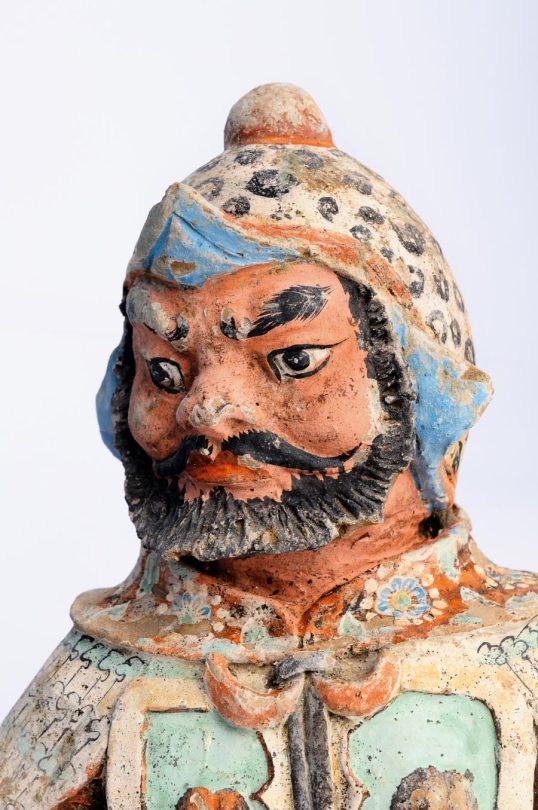


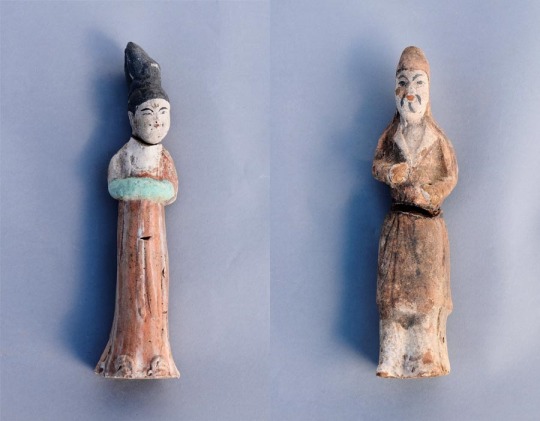
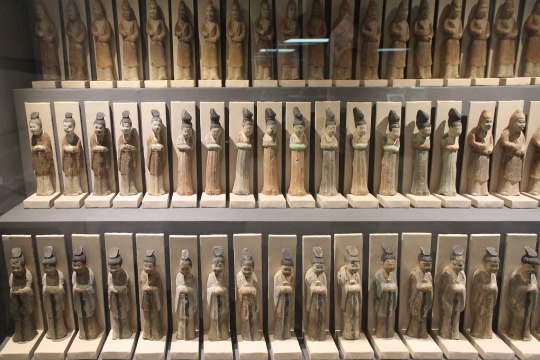

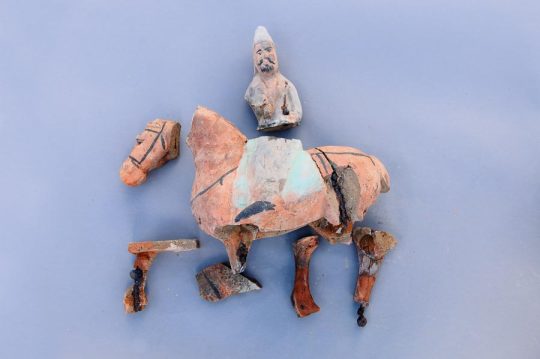

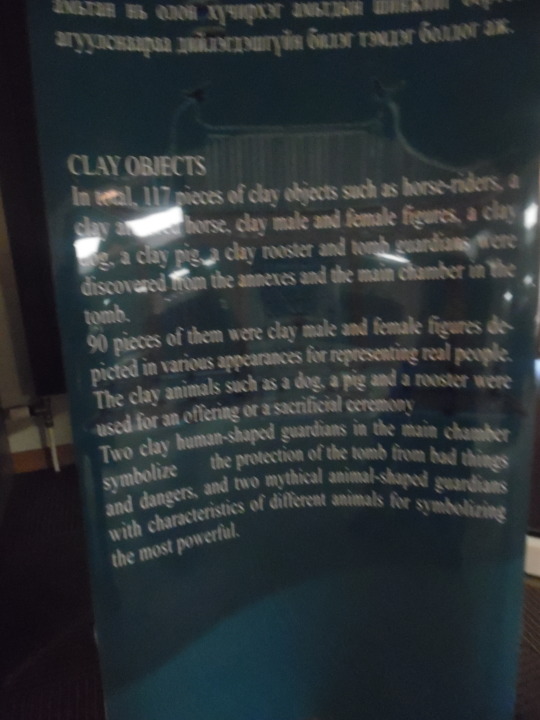


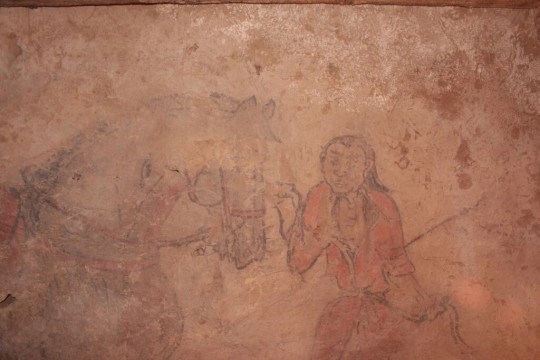
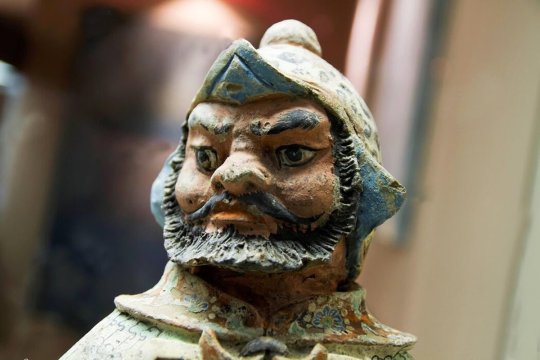
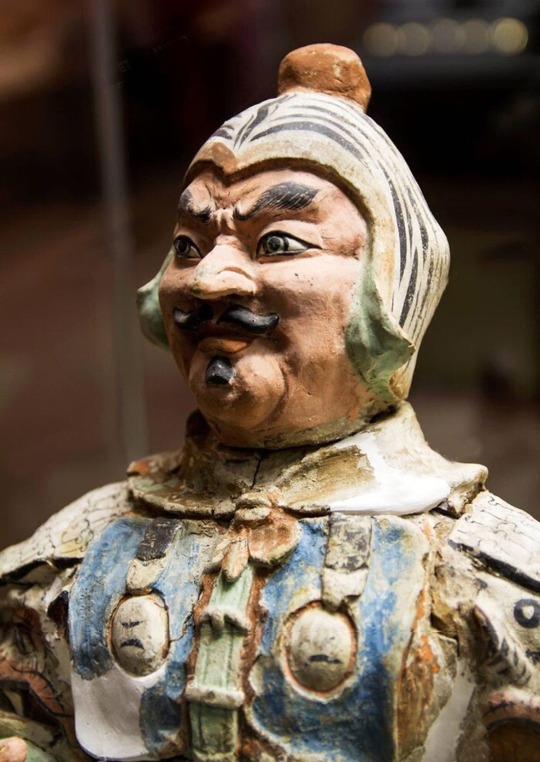
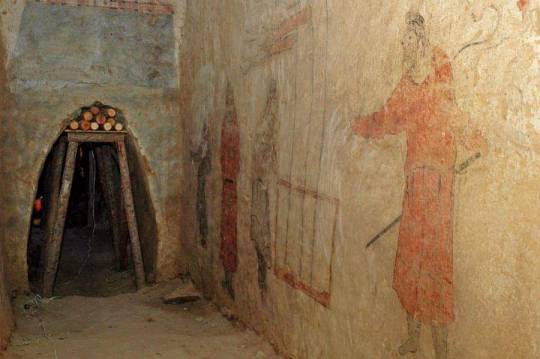

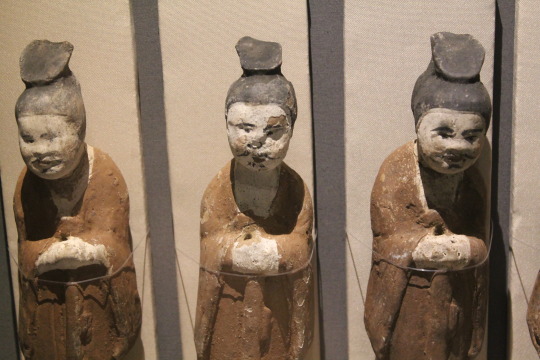
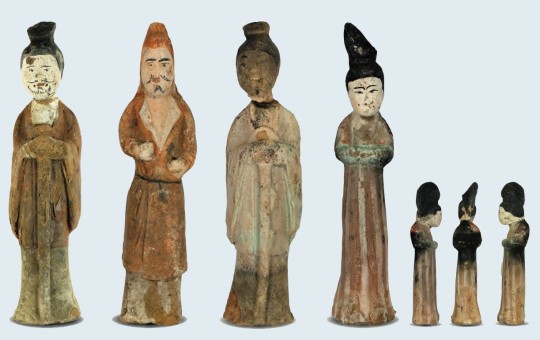

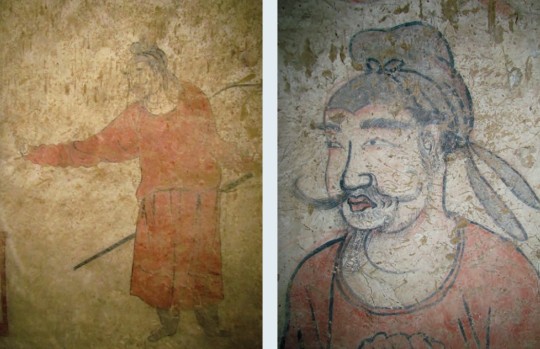
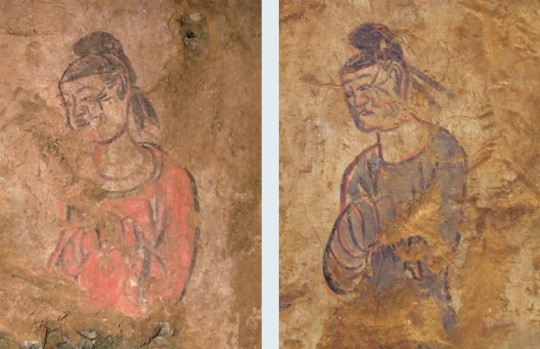







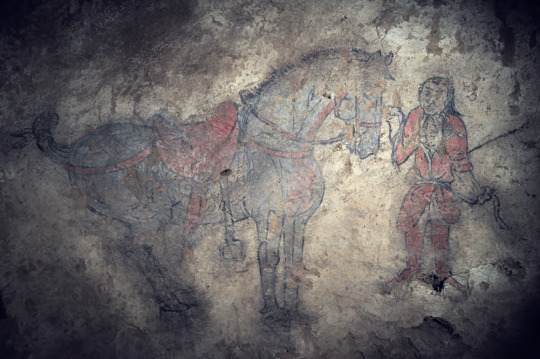
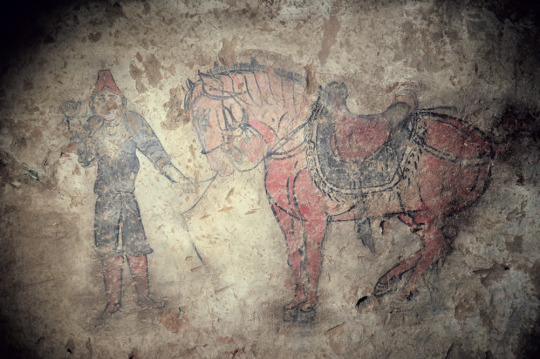
Shoroon Bumbagar, tomb of a Turkic (Gokturk) nobleman, 650-700 CE
"Like Chinese historians, Muslim writers in general depict the ‘Turks’ as possessing East Asian physiognomy. For instance, Sharaf al-Zamān Tāhir Marvazī describes them as being ‘short, with small eyes, nostrils, and mouths’ (1942: 53–4, 156). Similarly, Tabarī (d. 923) depicts the ‘Turks’ as being ‘full-faced with small eyes’ (1987: 21). In his Qābūs-nāma, the eleventh-century Ziyarid ruler Kai Kā'ūs also describes the ‘Turks’ as possessing ‘a large head (sar-i buzurg), a broad face (rūy-i pahn), narrow eyes (chashmhā-i tang), and a flat nose (bīnī-i pakhch), and unpleasing lips and teeth (lab va dandān na nīkū)’ (Kai Kā'ūs ibn Iskandar 1951a: 103; 1951b: 64). The Arab historian and geographer al-Mas'ūdī (896–956) writes that the Oghuz Turks residing in Yengi-kent, a town near the mouth of the Syr Darya, ‘are distinguished from other Turks by their valour, their slanted eyes, and the smallness of their stature’ (wa hum ashadd al-Turk ba’san wa aqsaruhum wa asgharuhum a‘yunan wa fī al-Turk man huwa aqsar min hā’ulā’) (al-Mas'ūdī 1962–: Vol. 1, 212). However, Muslim writers later differentiated the Oghuz Turks from other Turks in terms of physiognomy. Rashīd al-Dīn writes that ‘because of the climate their features gradually changed into those of Tajiks. Since they were not Tajiks, the Tajik peoples called them turkmān, i.e. Turk-like (Turk-mānand)’ (Rashīd al-Dīn Fażlallāh Hamadānī 1988: Vol. 1, 35–6; Rashiduddin Fazlullah 1998–99: Vol. 1, 31). Hāfiz Tanīsh Mīr Muhammad Bukhārī (d. c. 1549) also relates that after the Oghuz came to Transoxiana and Iran, their ‘Turkic face did not re-main as it was’ (1983: fol. 17a (text), Vol. 1, 61 (trans.)). Abū al-Ghāzī Bahadur Khan similarly writes that ‘their chin started to become narrow, their eyes started to become large, their faces started to become small, and their noses started to become big’ after five or six generations (Abu-l-Gazi 1958: 42 (text), 57 (trans.); Ebülgazî Bahadir Han 1975: 57–8). As a matter of fact, the mixed nature of the Ottomans, belonging to the Oghuz Turkic group, is noted by the Ottoman historian Mustafā Ālī (1541–1600). In his Künhü'l-ahbār, he remarks that the Ottoman elites of the sixteenth century were of mostly of non-Turkic origin: ‘Most of the inhabitants of Rum are of confused ethnic origin. Among its notables there are few whose lineage does not go back to a convert to Islam …’ (Ekser-i sükkān-i vilāyet-i Rūm meclis-i muhtelit ul-mefhūm olub ā‘yānında az kimsene bulunur ki nesebi bir müslüm-i cedīde muntehī olmaya) (Fleischer 1986: 254; Mustafā Ālī, Künhü'l-ahbār 1860–68: Vol. 1, 16)."
-Joo-Yup Lee & Shuntu Kuang, A Comparative Analysis of Chinese Historical Sources and Y-DNA Studies with Regard to the Early and Medieval Turkic Peoples
84 notes
·
View notes
Text
Random Fact #6,493
"The god of Christians, Jews, and Muslims made only two genders" is not a sound claim even if we were to assume for the sake of argument that God exists and created genders.
Israelite society had several genders, not just two.
Ay’lonit [איילונית]
A person who is identified as “woman” at birth but develops “man” characteristics at puberty and is infertile.
There are 80 references to this gender in the Mishna and Talmud and 40 in the classical midrash and Jewish law codes.
Androgynos [אנדרוגינוס] (Ancient Israel, from at least 1st century CE to 16th century CE)
A person who has both “male” and “female” sexual characteristics.
There are 149 references to the gender in the Mishna and Talmud and a whopping 350 mentions in classical midrash and Jewish law codes.
Saris [סריס:] (Ancient Israel)
A person who is identified as a “man” at birth but develops “woman” characteristics at puberty and/or is lacking a penis.
A saris can be “naturally” a saris (saris hamah), or become one through human intervention (saris adam).
There are 156 references to this gender in mishna and the Talmud and 379 in classical midrash and Jewish law codes.
Tumtum [טומטום] (Ancient Israel)
A person whose sexual characteristics are indeterminate or obscured.
According to Maimonides’ Mishneh Torah, Mada, Avoda Zara, 12, 4 Tumtum is not a separate gender exactly, but rather a state of doubt about what gender a person is (kind of like a Schrödinger’s gender?).
#did you know#christianity#judaism#islam#random facts#random fact#little known fact#random factoid#random factoids#yes really#history facts#israelites#third genders#trans history#intersex history#lgbt history#religion#transgender#jewish culture#jewish history#abrahamic religions#god of abraham#god of israel#gender stuff#queer history
116 notes
·
View notes
Text
Alfa Romeo 6 : La berline oubliée, mais pas sans mérite

Parmi les voitures les plus méconnues d’Alfa Romeo, l’Alfa 6 occupe une place à part. Lancée en 1979 après une gestation difficile, cette grande berline ambitieuse n’a jamais réellement trouvé son public. Pourtant, derrière son échec commercial se cache une voiture intrigante, aujourd’hui appréciée comme un classique discret.
Une genèse mouvementée
Conçue dès la fin des années 1960, l’Alfa 6 était censée incarner le haut de gamme de la marque pour concurrencer des modèles comme la BMW Série 5 ou la Mercedes Classe E. Initialement prévue pour un lancement en 1973, son développement a été retardé au profit de l’Alfetta, une berline plus compacte et commercialement plus urgente. Résultat : l’Alfa 6 n’a vu le jour qu’en 1979, en plein cœur de la deuxième crise pétrolière, un contexte économique peu favorable aux grandes berlines gourmandes en carburant.
Un design discret et pragmatique
L’esthétique de l’Alfa 6 reflète les préoccupations de l’époque en Italie, marquée par des troubles politiques et des enlèvements ciblant les élites. Alfa Romeo a opté pour un design volontairement sobre, presque austère, afin de ne pas attirer l’attention. Si cette approche se voulait rassurante, elle a également contribué à rendre la voiture peu désirable sur un marché où le prestige visuel était un argument de vente clé.
Sous le capot : un V6 inoubliable
Le principal atout de l’Alfa 6 réside dans son moteur V6 de 2,5 litres en aluminium, développant 156 ch. Ce bloc, réputé pour sa sonorité mélodieuse et sa souplesse, offrait des performances honorables pour l’époque, avec un 0 à 100 km/h abattu en 9 secondes et une vitesse de pointe de 185 km/h. Si les premières versions étaient équipées d’un système de carburateurs complexe et difficile à régler, une mise à jour en 1982 a introduit l’injection électronique, améliorant à la fois la fiabilité et la consommation.
Un châssis solide, mais une conception dépassée
Partageant sa plateforme avec l’Alfetta, l’Alfa 6 bénéficiait d’une architecture de suspension sophistiquée pour l’époque : double triangulation à l’avant et essieu De Dion à l’arrière. Elle se distinguait par une direction précise et une tenue de route agile, rivalisant avec des concurrentes allemandes. Cependant, l’absence de la transmission transaxle de l’Alfetta limitait son équilibre et son raffinement global.
À l’intérieur, l’Alfa 6 offrait une ambiance élégante mais étroite, héritage de sa base technique. Les matériaux utilisés étaient de bonne facture, en particulier pour une berline italienne des années 1980, souvent critiquées pour leur finition médiocre.
Une carrière commerciale désastreuse
Malgré ses qualités dynamiques et son moteur remarquable, l’Alfa 6 n’a jamais rencontré le succès. Les ventes ont été plombées par son positionnement maladroit, son style démodé et son retard de lancement. Sur les 12 070 exemplaires produits entre 1979 et 1986, seulement 134 ont été vendus au Royaume-Uni, un marché pourtant prometteur pour ce type de véhicule.
Un classique à redécouvrir
Aujourd’hui, l’Alfa 6 est davantage considérée comme une curiosité de collection qu’une berline de prestige oubliée. Son moteur V6, toujours aussi raffiné, et son châssis bien conçu en font une voiture agréable à conduire, tandis que son faible nombre d’exemplaires produits lui confère une certaine rareté. Avec son allure discrète, elle séduit les amateurs d’Alfa Romeo à la recherche d’un modèle atypique et accessible.
Fiche technique de l'Alfa 6 (1980-1986)
Moteur : V6 2,5 litres, injection
Puissance max : 158 ch à 5600 tr/min
Couple max : 212 Nm à 4000 tr/min
Transmission : Propulsion, boîte automatique ZF 3 rapports
Performances : 0-100 km/h en 9 secondes, Vmax 185 km/h
Poids : 1470 kg
Production totale : 12 070 exemplaires
L’Alfa 6 reste une pièce singulière dans l’histoire de la marque, une voiture qui incarne à la fois l’ambition et les défis auxquels Alfa Romeo a dû faire face à une époque troublée.
3 notes
·
View notes
Text
Bilan d'écriture...
... parce que cette année je peux en faire un <3
Je m'étais inscrite au challenge @gywo, découvert grâce à @vriddy, avec le défi d'écrire 150 000 mots sur toute l'année. J'ai réussi ✨
Mon total aura été de 163 037 mots, et ça fait carrément plaisir d'avoir été aussi créative, et créative productive, après cette longue période de repos qui a suivi la publication des deux tomes de L'Autre côté des ombres.
J'ai appris après toutes ces années que ces phases de repos sont nécessaires, et qu'il ne faut pas paniquer, ça reviendra. Et c'est tellement plus facile d'en profiter quand on ne panique pas parce qu'on ne produit pas (je sais, qui l'aurait cru ?)
Cette année, j'ai réussi à cocher les cases sex pollen, hanahaki et omégaverse qui manquaient cruellement à ma carrière de fangirl :D
Et parce que les stats, c'est bien, et que @gywo fournit une feuille de calcul juste jouissive, ces 163 037 mots, c'est quoi, concrètement ?
66 156 mots effectifs publiés sur AO3, en huit fics, dans le fandom Genshin. Ces 66 156 mots effectifs, c'est 119 101 mots de premier, deuxième ou troisième jet. J'ai remarqué que globalement, le nombre total de mots à la fin était à peu près la moitié de tout ce que j'ai écrit. La fic qui m'a demandé le plus de retravail est Et au matin se fâne, celle du trope hanahaki. Environ 42 000 mots pour un peu plus de 20 000 mots publiés, écrite sur 47 jours (sans compter la toute dernière relecture avant publication). L'Omégaverse Officielle fera pire (mais on verra ça l'année prochaine :D)
44 000 mots éparpillés entre des tout petits bouts de fics qui ne seront jamais finies, des bouts de fics que j'aimerais finir, l'Omégaverse Officielle qui en prend presque 30 000 à elle seule, et une originale que j'ai commencée début décembre :D J'ai hâte de pouvoir m'y consacrer, mais il faut d'abord que je finisse ce que j'ai commencé. En ce moment, il y a tellement de trucs que j'ai envie d'écrire, il me faudrait trois ou quatre doubles.
Mon mois le plus productif a été février avec plus de 27 000 mots d'écrits sur 17 jours, mais c'est en mars que j'ai passé le plus de jours à écrire : 19. Mon mois le moins productif a été novembre avec moins de 2 500 mots. C'est aussi le mois où j'ai écrit le moins de jours : 5.
Je me suis réinscrite à @gywo pour cette année, avec le même objectif de 150 000 mots ! Bonne année 2024 tout le monde, qu'elle soit celle qui nous portera vers un monde plus doux.
7 notes
·
View notes
Text
Bien qu'elle entraîne tant de souffrances et de pertes, la guerre est une activité rentable pour certains, comme les fabricants d'armes, leurs actionnaires et les banques qui prêtent de l'argent pour ces achats.

Le classement des plus grandes entreprises de l'industrie de la guerre, en fonction de leur chiffre d'affaires 2022. L'Amérique possède les plus grandes (tous les podiums) et les plus nombreuses (12 des 25 premières), rivalisant seulement avec la Chine (4), et loin derrière en volume, la France (4).
1. Lockheed Martin $63bn (fabricant du F35, des avions Hercules. Emploie 115 000 personnes, engloutit parfois 10 % du budget d'achat du Pentagone).
2. RTX (Raytheon) 39 milliards de dollars (missiles guidés Patriot, drones, systèmes d'interception de missiles, 182 000 employés). Au moins 20 membres du Congrès américain possèdent des actions dans ces deux entreprises, ce qui leur confère des intérêts directs lorsqu'ils votent sur les dépenses budgétaires.
3. Northrop Grumman 32 milliards de dollars (bombardiers, missiles intercontinentaux, 95 000 employés)
4. China Aviation Industry Company 31 milliards de dollars (500 000 employés dans de nombreuses sociétés subordonnées. 63 % des revenus proviennent de la production civile)
5. Boeing 30 milliards de dollars (156 000 employés, 44 % des recettes proviennent des ventes civiles, en plus de la production de bombardiers, de missiles, d'avions de chasse et d'avions de ravitaillement. A reçu de nombreuses aides de l'État, directement ou par le biais d'achats d'obligations par la banque centrale).
6. General Dynamics 30 milliards de dollars (106 000 employés, avions de chasse F16, missiles Tomahawk, chars Abrams et Leopard en collaboration avec l'Allemagne).
7. BAE Systems 25 milliards de dollars (Royaume-Uni, 93 000 employés, 10% détenus par Blackrock, chars Bradley, Challengers, chasseurs et sous-marins, collaboration avec de nombreuses entreprises précédemment citées et Airbus, coproduction de l'avion Concorde).
8. Norinco - North China Industrial Group 18 milliards de dollars (78 % de la production civile, 276 000 employés, armes, missiles, canons, drones, radars).
9. L3Harris Technologies (États-Unis) 14 milliards de dollars (46 000 employés, missiles hypersoniques, simulateurs de vol, systèmes de communication)
10. South China Industrial Group 13,5 milliards de dollars (78 % de production civile, 172 000 employés, munitions, fusils, artillerie)
11. Leonardo (Italie) 13 milliards de dollars (50 000 employés, avions de combat Typhoon en collaboration avec BAE et Airbus, satellites, hélicoptères, systèmes de ciblage)
12. Airbus EADS 12 milliards de dollars (France et autres pays de l'UE tels que les Pays-Bas et l'Allemagne. 80 % des revenus de l'aviation civile, 126 000 employés, participation dans Eurocopter, Eurofighter, gros porteurs A310)
13. HII Huntington Ingalls Industries (États-Unis) 10 milliards de dollars, construction navale, porte-avions, sous-marins d'attaque, frégates, 43 000 employés)
14. Thales (France) 9,6 milliards de dollars (48 % des recettes civiles, 76 000 employés, missiles, drones)
15. China Aerospace Technology Company 9,6 milliards de dollars (79 % des recettes civiles)
16. Leidos (États-Unis) 9,5 milliards de dollars (45 000 employés, 24 % de la production civile, aviation, informatique et équipement médical)
17. Amentum (États-Unis) 6 milliards de dollars
18. Booz Allen Hamilton (USA) 5,9 milliards de dollars
19. Rheinmetall (Allemagne) 5,1 milliards de dollars (25 000 employés, véhicules militaires)
20. Dassault Aviation (France) 5 milliards de dollars
21. Elbit Systems (Israël) 5 milliards de dollars (18 000 employés, drones, équipements de guerre électronique, contrat de modernisation des MiG et des IAR 300 pour la Roumanie, participation à la guerre de Gaza)
22. Rolls Royce (Royaume-Uni) 4,9 milliards de dollars (69 % de sources civiles, moteurs d'avion)
9 notes
·
View notes
Text
Quelques phrases intéressantes du livre saint des Juifs, le Talmud :
Sanhédrin 59a : « Tuer un goy (un goy est toute personne qui n'est pas juive) est comme tuer un animal sauvage. »
Baba necia 114, 6 : « Les Juifs sont des êtres humains, et les autres nations du monde ne sont pas des hommes, mais des bêtes. »
Aboda zara 26b : « même le meilleur des goyim devrait être tué. »
Nidrasch Talpioth, p. 225-1 : "Jéhovah a créé les non-Juifs sous forme humaine afin que les Juifs n'aient pas à utiliser les services d'animaux. c’est pourquoi les Gentils sont des animaux à forme humaine qui sont condamnés à servir les Juifs jour et nuit."
Yebhamoth 11b : « les rapports sexuels avec une fille sont autorisés si la fille a 3 ans. »
Schabouth hag 6d : « Les Juifs peuvent faire de fausses promesses comme excuses. »
Hikkoth akum x1 : "Ne sauvez pas les goyim en cas de danger ou de mort. ne montrez aucune pitié aux goyim."
Choschen hamm 266, 1 : "Un Juif peut avoir tout ce qu'il trouve si cela appartient à Akum (goyim). Celui qui restitue la propriété (goyim) pèche contre la loi, augmentant ainsi le pouvoir des contrevenants."
Szaaloth-utszabot, le livre de jore dia 17 : « un Juif peut et doit jurer de mentir lorsque les goyim demandent s'il y a quelque chose contre eux dans nos livres. »
Siméon Haddarsen, fol. 56-d : « Quand le Messie viendra, chaque Juif aura 2800 esclaves. »
Tosefta aboda zara b5 : « si un goy tue un goy ou un juif, il doit en répondre, mais si un juif tue un goy, il n'a aucune responsabilité. »
Schulchan aruch, choszen hamiszpat 388 : « Tous les biens des autres nations appartiennent à la nation juive, qui a donc le droit de jouir de tout ».
Seph. jp., 92, 1 : « Dieu a donné aux Juifs le pouvoir sur les biens et le sang de toutes les nations. »
Schulchan aruch, choszen hamiszpat 156 : "Si un goy doit de l'argent à un juif, un autre juif peut aller voir le goy, lui promettre de l'argent et le tromper. De cette façon, le goy fera faillite et le premier juif prendra possession de ses biens conformément à la loi."
Schulchan Aruch, Johre Deah, 122 : « Il est interdit à un Juif de boire du vin dans un verre touché par un goy, car son contact pourrait rendre le vin impur. »
10 notes
·
View notes
Text

Il y a 79 ans, 156 000 hommes Britaniques, Américains, Canadiens et Français débarquèrent en #Normandie. Souvenons-nous du courage de ces hommes qui n'avaient qu'un mot en tête : #Liberté. #Angers #CultureAngers #Histoire #Overlord #Landing. #DDay
5 notes
·
View notes
Text
1: 0 1 2 3 5 6 7 8 9 a b c d e f g h i k l m n o p r s t u v w x y z 33/36 (24/26) (9/10)
2: 09 15 19 26 58 62 93 95 97 98 99 aa ad ag ai ak al an ap ar as at av az be bl bu ca ce ch ck cl co cr ct da de dy ea ed ee eh ei em en eo er es et ev ex ey fi fr fy ga gc ge gi go gs gt gu ha he hi ho hr ic id ie if ik il im in io ir is it ke ki la le li ll lo lp lr ls ly ma mb me mi mm mo mp mu na nd ne ng no ns nt nu oe of og ok om on oo or os ot ou ov pe ph po pr ra rc re ri rn ro rs rt ry se si sk so ss st sy ta tc te tg th ti tl to tr ts tt tu uc ue um un ur us ut uy ve vi vo we wh wi xi ye yi yl yo zd 171/1296 (160/676) (11/100)
3: 198 199 626 993 997 aag ady age ain all alr and ant ape are ars ass atc ate ave azd ber bey blo blr bly but car cat cen chr clo com cou cre cta ctg den dev ead eak eat ehe eir emb ene eno ens ent eog era erc ere ero ery est eti ett evo exi eyo fie fre fyi gal gen gim got gue guy has hat hei hen her hey his hro ick ide ied ifi ify ike ill ime imm imp ing ins ion ist kil lai ler let lik lla lle lls log loo los lph lre mat maz mbe mbl mes met mic mmi mor mos mpo mpr muc nap nes nom nsi nta nti ntl num oes oge ogs ogu ome omo omp ond ook ore ort ose oso ost ote oun our out ove peo per phi por pos pre rag rce rea reh rin rns roe rog rom rta sed see sem ses sio ski som sse str sts syl tag tan tat tch ter tes tha the tif tim tin tly tri tte tum tur uch umb unt urn use ver vil vot who wil xis yes yin ylp yon you zda 205/46656 (200/17576) (5/1000)
4: 1993 1997 ains alle alre antl apeo asse atch aver azda beyo blog cars cent chro clos comp coun crea ctag dent devo eady eate ehen embl enes enom ensi enta enti eoge erag erce eroe etim ette evot exis eyon fied frea fyin gall gene geno gimm heir hens here hero hrom iden ifie ifyi illa ills imes immi impo kill lain lery lett like llai ller logs look lose lphi lrea matc mazd mber mblr mbly meti mick mmic more moso mpor mpre much nape nome nsio ntag ntif ntin ntly numb ogen ogue omet omos ompr orta oses osom osts otes ount over peog perc phis port post preh rage rcen read reak reat rehe ring roes rogu romo rtan semb sest sion skil some ssem stri sylp tage tant that thei they tifi tify time ting trin tter tumb turn umbe umbl unti urns used vera vill vote will xist ying ylph yond your 158/1679616 (156/456976) (2/10000)
5: aller alrea antly apeog assem avera beyon blogs centa chrom close compr count creat denti devot ehens embly enome ensio entag entif eogen erage ercen eroes etime etter evote exist eyond freak fying galle genes genom gimmi hensi heroe hromo ident ified ifyin illai immic impor kills lains lette llain llery loses lphis lread match mazda metim mmick mosom mport mpreh napeo nsion ntage ntifi ntify nting numbe ogene ometi omoso ompre ortan osest osome ounti peoge perce porta posts prehe rcent ready reate rehen rogue romos rtant sembl skill somet ssemb strin sylph tantl their tifie tifyi times tring tumbl turns umber umblr untin verag villa votes ylphi 109/60466176 (109/11881376)
6: allery alread apeoge assemb averag beyond centag chromo closes compre counti create dentif devote ehensi ension entage entifi entify eogene ercent etimes evotes galler genome gimmic hensio heroes hromos identi ifying illain immick import letter llains losest lready metime mosome mporta mprehe napeog ntifie ntifyi number ogenes ometim omosom ompreh ortant ountin peogen percen portan prehen rcenta rehens romoso rtantl sembly skills someti ssembl string sylphi tantly tified tifyin tumblr unting verage villai ylphis 74/2176782336 (74/308915776)
7: already apeogen assembl average centage chromos closest compreh countin dentifi dentify devotes ehensio entifie entifyi eogenes ercenta gallery gimmick hension hromoso identif illains importa metimes mportan mprehen napeoge ntified ntifyin ometime omosome omprehe ortantl ounting peogene percent portant prehens rcentag rehensi romosom rtantly sometim ssembly sylphis tifying villain 48/78364164096 (48/8031810176)
8: apeogene assembly chromoso comprehe counting dentifie dentifyi ehension entified entifyin ercentag hromosom identifi identify importan mportant mprehens napeogen ntifying ometimes omprehen ortantly peogenes percenta portantl prehensi rcentage rehensio romosome sometime villains 31/2821109907456 (31/208827064576)
9: apeogenes chromosom comprehen dentified dentifyin entifying ercentage hromosome identifie identifyi important mportantl mprehensi napeogene omprehens percentag portantly prehensio rehension sometimes 20/101559956668416 (20/5429503678976)
10: chromosome comprehens dentifying identified identifyin importantl mportantly mprehensio napeogenes omprehensi percentage prehension 12/3656158440062976 (12/141167095653376)
11: comprehensi identifying importantly mprehension omprehensio 5/131621703842267136 (5/3670344486987776)
12: comprehensio omprehension 2/4738381338321616896 (2/95428956661682176)
13: comprehension 1/170581728179578208256 (1/2481152873203736576)
the gimmick blogs are like tumblr’s rogue gallery. yes we’ve got some heroes, yes we’ve got some villains, but more importantly if you look over here you will see some freak who devotes all their time to counting the number of “t’s” in a post
162K notes
·
View notes
Photo
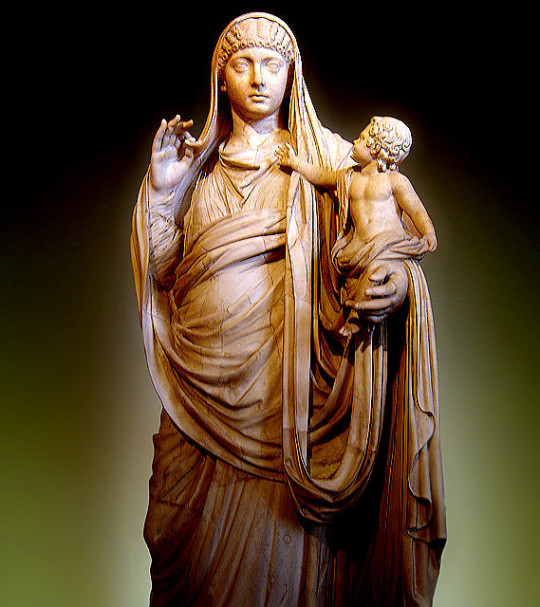
Britannicus
Britannicus (41-55 CE) was the second child and only son born to the Roman emperor Claudius (r. 41-54 CE) and Valeria Messalina (c. 20-48 CE). Seen as a threat by Claudius' fourth wife, Agrippina the Younger (15-59 CE), and her son, the future Nero (r. 54-68 CE), Britannicus was poisoned the night before his 14th birthday.
Early Childhood
Born on 12 February 41 CE, he was originally named Tiberius Claudius Caesar Germanicus; the name Britannicus was added after his father's invasion of Britain. In his The Twelve Caesars, the ancient historian Suetonius (69 to 130/140 CE) wrote, "Claudius would often pick little Britannicus up and show him to the troops or to the audience at the games either seated on his lap or held at arm's length" (197) Claudius had a son by his first wife Urgulanilla, but the boy died accidentally before coming of age, and Britannicus became the obvious choice to assume the purple upon the emperor's death. However, this would soon change when Claudius married his niece Agrippina the Younger (15-59 CE). The emperor's new wife brought with her a hidden agenda; she had high aspirations for her son, the future emperor Nero (r. 54-68 CE).
Agrippina the Younger was the daughter of Emperor Tiberius' (r. 14-37 CE) nephew Germanicus (15 BCE to 19 CE) and Agrippina the Elder (14 BCE to 33 CE), making her the great-granddaughter of Augustus (r. 27 BCE to 14 CE). Her marriage to Gnaeus Domitius Ahenobarbus produced one son Lucius Domitius Ahenobarbus, the future Nero (b. 37 CE). Gnaeus, who died when Nero was three, was extremely violent and was described by his contemporaries as "a despicable character." Two years after Domitius' birth, Agrippina was exiled by her brother Caligula (r. 37-41 CE). After Caligula's assassination in 41 CE, one of Claudius' first acts was to recall her. Her strong ties to the Julio-Claudians would pose a serious challenge to young Britannicus' position as the emperor's heir and, unfortunately for Britannicus, the highly aggressive Agrippina would stop at nothing until little Domitius upended his position. According to Matthew Dennison in his The Twelve Caesars, Agrippina "was not distracted by bodily appetites; arrogance and an undistracting focus steadied her performance." (156)
In 40 CE Domitius' father died of dropsy. Upon her return to Rome from exile, the widowed Agrippina married Gaius Passienus Crispus, who had recently divorced Gnaeus Domitius Ahenobarbus' sister Domitia. The marriage ended before 47 CE, possibly due to poisoning. Agrippina inherited his vast wealth, making her extremely rich. Widowed twice, she set her sights on husband number three: her uncle Claudius. Claudius showed little interest in obtaining another wife; there was still strong competition for the old emperor: Aelia Paetina (his second wife) and Lollia Paulina (Caligula's third wife). Lollia would later be exiled on the orders of Agrippina where a suicide would soon follow. However, Claudius' financial secretary Marcus Pallas favored Agrippina, and on 1 January 49 CE, she became Claudius' fourth wife.
Having married the emperor, her next objective was to secure the adoption of her son, and on 28 February 50 CE, Lucius Domitius became Nero Claudius Drusus Germanicus Caesar. Suetonius wrote, "In his last years, Claudius made it pretty plain that he repented of having married Agrippina and adopted Nero" (204). Realizing, the possible danger posed by Nero and his mother, Claudius told his son repeatedly "to grow up quickly." With the adoption of Nero secured, Agrippina turned her attention to the one serious obstacle to her son becoming the emperor: Britannicus.
Continue reading...
32 notes
·
View notes
Text

Le 20ème recensement partiel de la population aura lieu du 16 janvier au 22 février 2025. Le recensement permet de savoir combien de personnes vivent en France et d’établir la population officielle de chaque commune. Il fournit des statistiques plus fiables, plus récentes sur le nombre de logements, le nombre d’habitants et leurs caractéristiques (âge, profession exercée, conditions de logement, modes de transport, déplacements quotidiens…). Les résultats du recensement éclairent les décisions publiques en matière d’équipements collectifs (écoles, hôpitaux, crèches, transport…). Ils aident également les professionnels à mieux évaluer le parc de logements, les entreprises à mieux connaître leur clientèle potentielle ou les disponibilités de main-d’œuvre, les associations à mieux répondre aux besoins de la population. Il est enfin à la base du calcul de la dotation globale de fonctionnement attribuée par l’Etat aux collectivités. Pour rappel, le comptage traditionnel organisé tous les huit ou neuf ans a été remplacé par des enquêtes de recensement annuelles depuis janvier 2004. Nouveauté 2025 En plus du recensement de la population classique, certains foyers, sélectionnés par l’INSEE, seront concernés par l’enquête Familles. A quel âge devient-on parent ou grand-parent ? Comment vivent les enfants de parents séparés ? Combien de personnes n’ont jamais vécu en couple ? Autant de questions que se posent l’INSEE. Cette enquête vise à mieux comprendre les familles d’aujourd’hui et leur histoire. Si vous voulez en savoir plus sur l’enquête Familles, rendez-vous sur www.insee.fr. Le recensement à Montbéliard Si la population montbéliardaise est considérée dans son ensemble, tous les foyers ne seront pas recensés pour autant. En effet, dans les communes de plus de 10 000 habitants, le recensement est réalisé à partir d'échantillons représentatifs de la population. Concrètement, les agents recenseurs interviendront dans 1 156 foyers montbéliardais. Une fiche logement et une fiche par habitant (bulletin individuel) seront remplies par la ou les personne(s) résidant à l'adresse recensée. Certains foyers peuvent également recevoir une notice qui présente l’enquête Familles et comporte toutes les informations nécessaires pour y répondre. Comment ça se passe ? Au nombre de six, les agents recenseurs ont d’ores et déjà fait une tournée de reconnaissance, afin de vérifier les adresses et le nombre de logements. Un courrier d’information et de la documentation générale sont ainsi déposés dans les boîtes aux lettres des personnes habitant les foyers sélectionnés. Les questionnaires sont ensuite complétés et récupérés plus tard après avoir fixé un rendez-vous. Certaines personnes peuvent être momentanément indisponibles ou astreintes à des horaires particuliers. Dans ce cas, elles ne doivent pas hésiter à le faire savoir. Elles peuvent pour cela appeler le service Population Réglementation au 03 81 99 22 22. A noter également que depuis 2016, les personnes recensées ont la possibilité de remplir lesdits formulaires via Internet. Plus simple et rapide, ces derniers reçoivent de la part des agents recenseurs leurs identifiants de connexion au site www.le-recensement-et-moi.fr. Répondre au questionnaire de recensement est un acte citoyen et obligatoire. Une formation spécifique Avant d’entamer leurs tournées, les agents recenseurs montbéliardais ont suivi une journée de formation. Présentation des principes généraux du recensement, intérêt, cadre réglementaire et préparation aux diverses situations qu'ils pourraient rencontrer… Tous ces thèmes ont fait l’objet d’un exposé détaillé de la part de Anne-Laure PERGAUD, superviseur de l’INSEE. Salima Kaddouri, Hélène Fernandes, Adeline Filz, Abdessamad Kaddouri, Jean-Marc Maugué, Jacques Girot, les six agents recenseurs de 2025 se présenteront aux domiciles d’une partie des Montbéliardais. Répartition des secteurs Les habitants tirés au sort au centre-ville seront visités par Jean-Marc Maugué. Le quartier des Batteries du Parc sera partagé entre deux agents Hélène Fernandes et Abdessamad Kaddouri. Le Mont-Bart sera, quant à lui, recensé par Adeline Filz et Jean-Marc Maugué. Les habitations situées au quartier de la Chiffogne et Faubourg de Besançon seront évaluées par Hélène Fernandes. Abdessamad Kaddouri recensera le Pied des Gouttes et le quartier Pergaud Saint-Aubin. Jacques Girot s’occupera, quant à lui, du quartier de la Citadelle. Concernant les autres quartiers, Salima Kaddouri viendra au Coteau Jouvent, au Petit-Chênois et aux Portes du Jura. Important : les agents recenseurs sont munis d'une carte tricolore comportant leur photo et la signature du maire et sont tenus au secret professionnel. Que disent les derniers chiffres ? Au 1er janvier 2022, et selon les derniers chiffres de la population légale en France publiés par l’INSEE, la commune de Montbéliard compte 25 999 habitants. Contrairement au 1er janvier 2021 où ils étaient 26 008 habitants. La population reste donc stable. Un équilibre qui s’explique, entre autres, par les actions et projets mis en œuvre par la municipalité afin de rendre Montbéliard plus attractive ou encore par la dynamique de l’emploi dans le territoire. On peut également noter les opérations d’urbanisme et immobilières telles que les quartiers des Blancheries, des Hauts du Miémont ou du Mont Chevis, qui proposent une nouvelle offre de logements, prête à accueillir de nouveaux résidents venus de l’extérieur. Read the full article
0 notes
Text
Beneficii de transport în 2025 – articol de Iulia Zorzoliu
În anul 2025 vor fi aplicate modificări în ceea ce privește beneficiile de transport pentru mai multe categorii de persoane, ca urmare a intrării în vigoare a Ordonanței „trenuleț”. Conform OUG nr. 156/2024, adoptată pe 31 decembrie 2024, începând cu anul 2025, beneficiile de transport redus pentru studenți vor fi limitate. Următoarele reguli vor fi aplicate: pe de-o parte reducerea de 90% se…
0 notes
Text
89 / 3
p. 146 : "c'est que la rencontre est organisée sous l'égide de l'idéologie libérale du "choix". (les sites de rencontres) Internet met ainsi le moi dans une position contradictoire : d'un côté, le moi est invité à se tourner vers l'intérieur, obligé à se concentrer sur lui-même pour saisir et transmettre ce qu'il a d'essentiellement unique, à savoir des goûts, des opinions, des fantasmes et une certaine compatibilité émotionnelle. D'un autre côté, le moi est traité comme une marchandise qu'on expose sur la place publique. (...) Cela constitue une rupture sensible avec la tradition de l'amour."
p. 151 : "Quand les gens se présentent aux autres d'une façon qui ne laisse aucune place au corps, ils appliquent à leur propre moi les idées reçues concernant l'image de ce qu'est une personne désirable. En d'autres termes, l'usage du langage écrit pour la présentation de soi accentue paradoxalement l'uniformité, la standardisation et la réification. Je dis "paradoxalement" parce que, quand les gens remplissent ces questionnaires, on leur fait croire qu'ils sont en train d'expérimenter leur unicité, et que c'est cette unicité qu'ils communiquent à d'autres."
p. 155 : "Ce qui s'explique par le fait qu'une grande partie de la magie que nous attachons traditionnellement au sentiment amoureux est liée à une économique de la rareté, dans laquelle la nouveauté et l'émotion sont possibles. Au contraire, l'économie d'internet est une économie de l'abondance, où le moi doit faire un choix, maximiser ses options et utiliser des techniques de calcul en termes de coûts et profits et d'efficacité."
p. 156 : "Ces rencontres rapides sont le fruit évident du désir de maximiser l'efficacité de la recherche, en ciblant la population avec une grande précision et en limitant l'interaction à un cadre temporel strict et clairement circonscrit. On a là une parfaite illustration de ce que Ben Agger appelle le "capitalisme rapide", lequel a deux caractéristiques : la première, c'est que la technique capitaliste tend à comprimer le temps afin d'accroître l'efficacité économique ; la deuxième, c'est que le capitalisme tend à effacer les limites entre espace privé et espace public et à interdire aux gens de disposer d'un temps et d'un espace privés. Dans le capitalisme rapide, ces deux caractéristiques sont étroitement liées, car la technique et la marchandise colonisent le temps et l'espace".
p. 157 : "Fidèle à la logique de la culture et de la consommation, la technique nous permet de et même nous invite à spécifier de plus en plus nos goûts et à les raffiner. Contrairement au besoins, qui sont fixes, le raffinement est par nature variable : dans le domaine de la gastronomie, même le plat le plus raffiné peut toujours être surpassé. Dans le royaume des rencontres, ce processus de raffinement du goût a une conséquence importante : la recherche de l'autre devient par nature instable. Être raffiné, cela signifie précisément être à la recherche de manières d'améliorer sa position sur le marché."
p. 161 : "Il ne vous a sans doute pas échappé que les personnes que j'ai citées jusqu'ici manifestent un mélange de lassitude et de cynisme, ce cynisme étant la tonalité dominante (...). Je pense que ce cynisme est celui auquel pensait Adorno quand il écrivait que, dans la culture contemporaine, les consommateurs se sentent obligés d'utiliser les produits vantés par la publicité tout en sachant très bien à quoi s'en tenir.
p. 162 : Savoir à quoi s'en tenir et obéir, nous dit Adorno, tel est précisément le mode dominant d'utilisation des produits de consommation dans les sociétés capitalistes tardives. Le cynisme est le ton qu'on a toutes les chances d'employer quand on sait à quoi s'en tenir et qu'on se sent malgré tout obligé de faire la même chose à de nombreuses reprises."
Illouz Eva, ibid.
0 notes